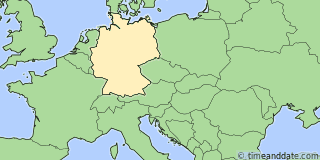2025年3月30日 (日), 2時00分
Daylight Saving Time (DST) Not Observed in Year 1922
Germany observed Central European Time (CET) all year.
DST was not in use in 1922.
The previous DST change in Germany was on 1918年9月16日月曜日.
Try selecting a different year below.
When Does DST Start and End in Germany?
All of Germany uses Daylight Saving Time (DST) during part of the year. The DST period starts on the last Sunday of March and ends on the last Sunday of October, together with most other European countries.
Central European Time (CET) is used as standard time, while Central European Summer Time (CEST) is observed when DST is in force.
Daylight Saving Time History in Germany
- Germany first observed Daylight Saving Time in 1916.
- Germany has observed DST for 59 years between 1916 and 2025.
- Previous time with no Daylight Saving Time was 1979.
- See Worldwide DST Statistics
First Country to Use DST
Although a small town in Canada had experimented with seasonal clock changes as early as 1908, Germany was the first country to use nationwide DST. On April 30, 1916, at the height of World War I, the German Empire turned its clocks forward for the 1st time. Many European countries followed suit just weeks later.
The measure was abolished after the war, only to be re-introduced during World War II. From 1940 to 1942, Germany observed year-round DST.
After World War II, parts of Germany controlled by the Soviet Union followed doppelte Sommerzeit, double DST, advancing their clocks by 2 hours instead of 1. The rationale was to synchronize German clocks with the local time in Moscow.
DST was discontinued in 1950. In 1980, following an initiative by East Germany, the country re-introduced the measure. Though controversial, DST has been used in Germany ever since.
Since Switzerland did not introduce DST until 1981, the German exclave of Büsingen, which is situated within Swiss territory, did not observe DST together with the rest of Germany in 1980.
